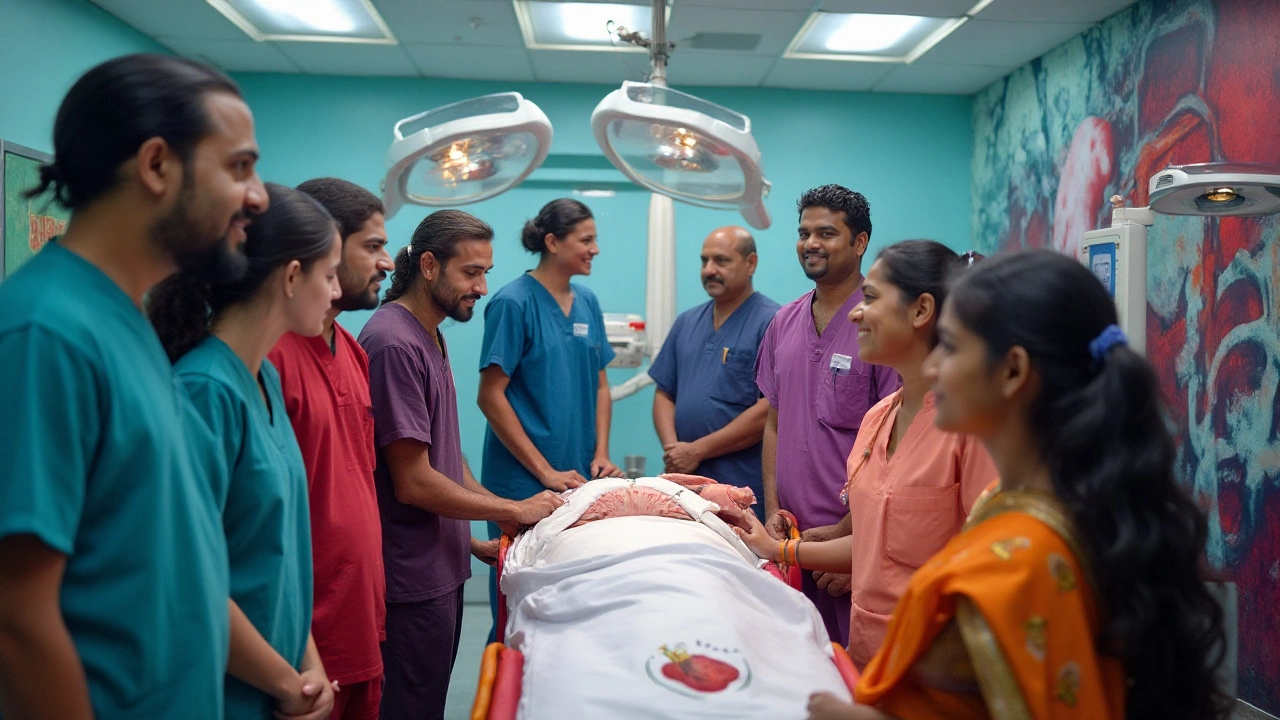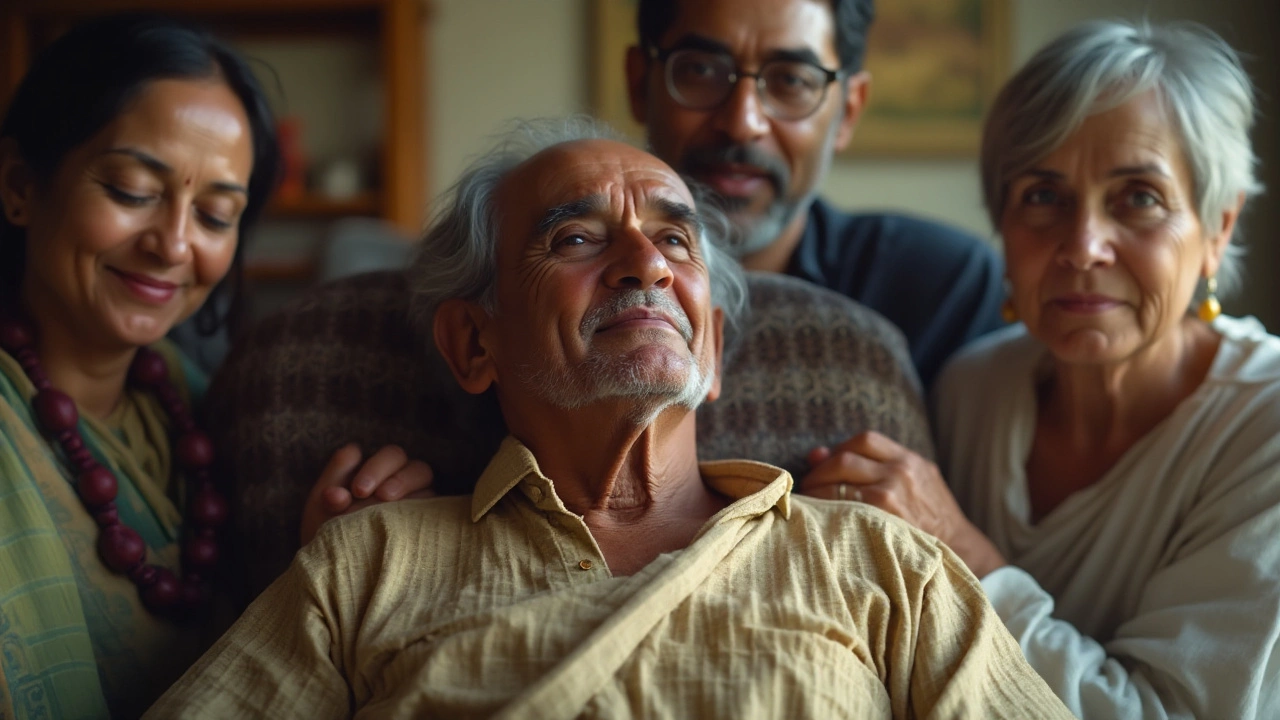
Heart surgery is not only a pivotal medical intervention but also a journey through pain, healing, and resilience. Regardless of whether it's a bypass or a delicate valve repair, each procedure comes with its unique challenges, especially when it comes to managing pain afterward.
While the intricacies of heart surgery are left to skilled surgeons, understanding what patients typically endure in terms of discomfort can prepare them better for what's ahead. Pain management, both physical and mental, plays a crucial role in recovery. Let's explore the most painful surgeries involving the heart and how patients move past this difficult phase.
- Introduction to Heart Surgery
- Types of Heart Surgeries
- Pain Levels and Factors
- Common Pain Management Techniques
- Patient Experiences and Stories
- Tips for Better Recovery
Introduction to Heart Surgery
Heart surgery represents a significant medical advancement, often regarded as a beacon of hope for those grappling with serious cardiac conditions. The journey into this domain begins with understanding the intricate network that keeps our heart ticking: a complex, symphonic coordination of muscles, valves, and vessels. When this system falters due to myriad reasons like disease or lifestyle factors, surgical intervention often emerges as a life-saving answer. With more than half a million heart surgeries performed annually, this specialized medical field has transcended its early hurdles to become a sophisticated health service. Advances in technology and technique have rendered many heart procedures less invasive, thereby promising better recovery rates and reduced pain for patients.
The types of heart surgery can vary widely, from the routine angioplasty to the more elaborate coronary artery bypass grafting (CABG). Each of these procedures addresses specific heart ailments, tailoring the approach to meet individual patient needs and conditions. Renowned for its efficacy, cardiac procedures have not only increased life expectancy for countless individuals but have also significantly improved quality of life. It's fascinating how a single intervention can address myriad complications, from clogged arteries to faulty heart valves. The evolution of techniques stands as a testament to the relentless pursuit of innovation in medical science. Innovations like robotic-assisted surgery and minimally invasive procedures are not just expanding the boundaries of what is possible but also minimizing patient discomfort post-surgery. In this regard, it is noteworthy to mention Dr. Michael DeBakey, a pioneering heart surgeon whose innovations paved the way for modern techniques.
"When you work in extreme situations, you find a way to cope and learn." — Dr. Michael DeBakey
Surgical teams operate with meticulous precision, often spending hours during complex operations. A model of teamwork, these surgical endeavors require not only the lead surgeon’s unmatched skill but also the dedicated attention of anesthesiologists, nurses, and technical staff. This collective expertise ensures an environment where patient safety is prioritized above all. Despite the technical nature of heart surgery, compassionate care remains central. Patients are considered partners in their health journey, equipped with comprehensive information pre- and post-surgery to aid informed decision-making and optimal recovery. As we delve into the specifics of these procedures, we gain an appreciation of the incredible resilience of human physiology and the transformative power of modern medicine.
Types of Heart Surgeries
When it comes to heart surgery, there are several types that cater to different conditions, each with its own methodologies and implications. The common denominator among them is the goal to restore and maintain heart health. One of the most frequent procedures is Coronary Artery Bypass Grafting (CABG), often referred to as bypass surgery, which aims to improve blood flow to the heart. This intricate procedure involves creating new pathways around clogged arteries to ensure that oxygen-rich blood reaches the heart efficiently.
Another significant surgery is heart valve replacement or repair which addresses problems with one or more of the heart's valves. This type of surgery is crucial for ensuring that blood flows in the right direction, without any hindrance. The valves can either be repaired or replaced with artificial or biological alternatives. This choice depends largely on the patient's condition and surgeon's recommendation. Valve surgery can dramatically improve quality of life, reducing symptoms such as shortness of breath and fatigue.
Less Invasive Approaches
The advent of technology has introduced the possibility of minimally invasive cardiac surgeries. These techniques are conducted through smaller incisions, leading to reduced pain and faster recovery times. Procedures like Transcatheter Aortic Valve Replacement (TAVR) have become popular, especially for elderly patients who may not tolerate a full sternotomy. These operations allow surgeons to fix or replace heart valves without the need for open-heart surgery, underscoring significant advancements in cardiac care.
Heart transplantation remains the most complex and challenging type of heart surgery. It is often reserved for patients who have severe heart failure not alleviated by other treatments. This involves replacing the diseased heart with a healthy one from a donor, and although it is life-altering for recipients, it requires lifelong management and care due to potential risks of rejection and complications. Each type of surgery, while unique, shares the common purpose of extending life and improving its quality for patients.
According to the American Heart Association, "Choosing the right type of heart surgery is crucial and depends on a range of personal health factors and professional medical advice."
The type of surgery can greatly influence recovery time and pain levels, thus impacting a patient's post-op experience significantly. Surgeons weigh multiple factors, including the patient’s medical history, age, and condition severity, before deciding on the best surgical approach. Understanding what each type of surgery entails can help patients prepare mentally and physically for the procedure and recovery phase, providing them with a clearer vision of the journey ahead.

Pain Levels and Factors
Pain is unquestionably a significant aspect of heart surgery. The intensity can vary greatly depending on the type of procedure, individual pain tolerance, and the exact methods used during surgery. Generally, the procedures such as open-heart surgery, which involves a sternotomy or opening of the chest, are regarded as some of the most painful. This is not only due to the nature of the incision but also because the chest bone is split and wired back together, thus requiring substantial healing time. Patients often report pain levels as moderate to severe in the initial days post-surgery, which requires diligent management through medication and care strategies provided by healthcare teams.
Recovery pain is influenced by several factors, not least the scale of the intervention itself. For instance, surgeries necessitating the use of a heart-lung bypass machine may impose a physical toll that exacerbates discomfort due to the intricate postoperative care required. Many patients describe experiencing discomfort that extends to the back and shoulder areas, often unexpectedly so, due to nerve disturbances during the operation.
Susan Kiesling, a renowned cardiothoracic surgeon, once explained, "The procedure is as much a psychological journey as a physical one; understanding pain is crucial in facilitating recovery."
Different individuals have varied thresholds for pain, which means the level of discomfort experienced can sometimes diverge from typical expectations. Psychological readiness, prior anxieties about cardiac procedures, and previous medical history significantly impact the subjective experience of pain. Reports indicate that effective communication with the medical team beforehand helps in setting realistic expectations, creating a sense of preparedness that can ameliorate the apprehension and perceived intensity of pain post-surgery.
Age, overall health prior to the surgery, and the presence of other medical conditions are further factors influencing recovery speeds and pain levels. Older patients or those with pre-existing conditions like diabetes or chronic obstructive pulmonary disease (COPD) often experience heightened pain perception or extended recovery periods. The body's response to surgery is multifaceted; inflammation, swelling, and immune response all contribute to postoperative pain.
An interesting aspect involves the evolution of surgical techniques. In recent times, minimally invasive heart procedures have gained substantial traction. These interventions, requiring smaller incisions, generally afford patients a reduced pain impact post-surgery, in contrast to traditional open-heart techniques. Data suggests a lower incidence of intensive pain management requirements post-minimally invasive surgeries, as the trauma inflicted on bodily tissues is significantly less.
The nature of postoperative pain management has thus become central to recovery protocols. Medical practitioners emphasize not only pharmaceutical solutions but also rehabilitation exercises, breathing techniques, and psychological support as pivotal in assuaging pain. These comprehensive approaches encourage patient involvement, improving recovery outcomes while reducing anxiety associated with painful surgery.
Common Pain Management Techniques
Navigating the aftermath of heart surgery often revolves around effectively managing the inevitable discomfort. Pain management is crucial not just for comfort but also for fostering a smoother, quicker recovery. In hospitals and beyond, doctors and health professionals employ a range of techniques tailored to both the type of cardiac procedure performed and the individual needs of the patient.
Pharmacological interventions are commonly used, with opioids being the most frequently prescribed. They provide significant relief, but come with side effects like nausea or dependency risks. Hence, their usage is carefully monitored by healthcare providers. Alongside opioids, non-steroidal anti-inflammatory drugs (NSAIDs) and acetaminophen are often prescribed. These help to reduce pain and swelling, proving particularly helpful in the initial post-operative days when pain may peak.
In addition to medications, non-pharmacological methods play a vital role in pain management. Techniques such as transcutaneous electrical nerve stimulation (TENS) utilize low-voltage electric currents to disrupt pain signals, offering some patients welcome relief. Physical therapy is also key; gentle exercises and movements not only enhance mobility but can significantly reduce pain by preventing stiffness and improving blood flow.
Some hospitals incorporate innovative approaches like mindfulness and meditation sessions. These strategies help patients manage perceptions of pain and stress. As one cardiac nursing specialist noted,
"Mindfulness can be transformative, helping patients cope with pain in a way that medications alone cannot."This approach emphasizes recognizing pain without judgment, which can be particularly effective for those frightened or anxious about their recovery journey.
Additionally, deep breathing exercises are recommended to decrease pain perception by relaxing the body and mind. Controlled breathing techniques help in lowering heart rate and blood pressure, which not only aids healing but fosters a tranquil environment within the body. While less traditional, aromatherapy with essential oils like lavender or eucalyptus can provide soothing effects, supporting a positive mindset which indirectly aids in pain management.
Ultimately, effective pain management after heart surgery involves a tailored combination of medication, physical activity, mental exercises, and innovative therapies. Healthcare teams aim to balance these elements to ensure that recovery is as seamless as possible, reducing the long-term burden of pain on the patient's road back to health.

Patient Experiences and Stories
In the realm of heart surgery, patient experiences vary as much as the people themselves. One common thread, though, is the resilience they exhibit throughout this arduous journey. Take, for example, Jacob, a 58-year-old father who underwent a coronary artery bypass grafting procedure. His experience speaks volumes about the physical and emotional trials faced by those battling cardiac ailments. He recalls the initial fear upon diagnosis, which was swiftly followed by the daunting task of preparing mentally for the operation. Jacob describes waking up from surgery with a range of sensations that he never anticipated. From the tightness in his chest, akin to an elephant sitting on him, to the sharp pangs that accompanied every breath and movement, the pain was both startling and intimidating.
What Jacob quickly learned, though, was the importance of pain management. Hospital staff introduced him to a regimented schedule of medications and encouraged him to engage in light activities when possible. "Listen to your body, but don't be afraid to move," was the mantra passed along by his caring nurses. This advice, paired with stories from other patients, helped Jacob navigate his recovery. He learned that each day might present new challenges, yet with the right support, each new victory was within reach. Today, Jacob credits his successful recovery not only to his medical team but also to the community of fellow heart surgery patients who shared their stories of endurance and hope.
Another compelling narrative is that of Maria, who faced her surgery with a mix of dread and determination. Her procedure, a straightforward valve replacement, turned into a testimony of her unwavering resolve. Maria shares that the key to enduring this painful surgery was in accepting help, both physically and emotionally. "I leaned on everyone, from my doctors to my family," she recalls smiling. The post-operative pain was tough, yes, but what surprised her were feelings of vulnerability and dependence, especially for someone used to being fiercely independent. Maria found solace in physical therapy sessions, where she met others who were also eager to return to normalcy. These interactions provided encouragement and practical tips, like how slightly adjusting the angle of her bed relieved pressure on her chest.
Maria also found inspiration in a quote she read during recovery:
"One day you will tell your story of how you overcame what you went through, and it will be someone else's survival guide."These words rang true as she took meticulous notes on her healing journey, which she now eagerly shares with new patients at her cardiologist's office. Her story, like many others, is a beacon of hope and wisdom, particularly useful for those who walk a similar path. Through open conversations about their experiences, both Jacob and Maria emphasize the significance of community support, mindset, and proactive pain management in surviving and thriving after heart surgery.
In exploring these stories, a consistent theme emerges: while each patient's journey is uniquely personal, many encounter shared milestones and obstacles. These stories remind us that healing from heart surgery is not merely a physical recovery but also an emotional and communal journey, deeply enriched by the experiences and voices of those who have traveled it before.
Tips for Better Recovery
Recovering from heart surgery is a journey marked by patience and persistence. Understanding that every patient's path is unique can help set realistic expectations. The first step towards a smooth recovery is to closely follow the surgeon’s advice and recommendations. This may include prescribed medications, dietary changes, and physical activity restrictions. It's essential to take all medications as directed to manage pain and prevent complications. Patients should also focus on a balanced diet, rich in vitamins and minerals, to support the healing process. This includes plenty of fruits, vegetables, lean proteins, and whole grains to rebuild strength and bolster overall health.
Physical activity is another crucial aspect of recovery from cardiac procedures. Many patients are advised to engage in light exercises shortly after surgery to improve circulation, prevent blood clots, and rebuild stamina. Under the guidance of a healthcare provider, activities such as walking or gentle stretching can significantly aid recovery. It's important to listen to one's body and avoid pushing too hard during this delicate phase. Additionally, monitoring for any warning signs, such as increased pain, swelling, or unexpected symptoms, can help ensure timely medical intervention if needed. Incorporating periods of rest is equally vital, as the body needs time to recuperate.
In terms of emotional and psychological well-being, recovery can be just as challenging. Patients often experience a range of emotions, from anxiety to depression. Maintaining a support network of family, friends, and healthcare professionals can greatly ease this emotional toll. Engaging in relaxation techniques, such as meditation or deep-breathing exercises, can help manage stress levels. Talking to a therapist or joining a support group allows sharing experiences and feelings with others who understand what you're going through. According to a recent statement from the American Heart Association, "emotional support after surgery is as critical as physical healing."
Regular follow-up appointments with healthcare providers are essential to track progress and make necessary adjustments to the recovery plan. During these visits, doctors can provide more tailored advice, adjust medications, and address any ongoing concerns. It's also crucial to avoid smoking and limit alcohol consumption, as both can interfere with healing and increase the risk of complications after heart surgery. Finally, educate oneself about heart health and how to maintain it moving forward. Patients should explore resources that provide information on lifestyle changes that support long-term heart health and prevent future issues.

Write a comment